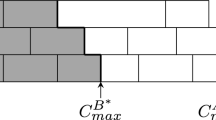Abstract
This study considers the problem of scheduling two interfering job sets A and B that comprise \({n_A}\) and \({n_B}\) jobs, respectively, on m parallel machines. For the jobs in the set A, we are interested in minimizing the total weighted tardiness (TWT) and for the jobs in the set B, we are interested in minimizing the total completion time (TCT). Although these job sets are evaluated using different criteria, they must be processed using the same resources (machines, workers, and tools), causing interference. In this study, not only is interference considered, but also the operating speed of machine is treated as an independent variable, which affects the peak power. Peak power is considered here since electricity costs for production facilities rise sharply if instantaneous power demand exceeds contract capacity, so production schedules that reduce peak power reduce the cost of energy. Therefore, this paper uses a constraint on peak power consumption while TWT and TCT are simultaneously minimized. This study proposes the domination number-based genetic algorithm (DNGA) to generate a set of non-dominated solutions to the problem, so the decision-maker can evaluate the trade-offs and select the schedule to be implemented. The DNGA is compared with NSGA-II, which has been demonstrated to be the most efficient algorithm for multi-objective optimization, in terms of quality, diversity and computation time. Experimental results reveal that DNGA can find better solutions more quickly than can NSGA-II.





Similar content being viewed by others
References
Tuong NH, Soukhal A (2009) Interfering job set scheduling on two-operation three-machine flowshop. In: IEEE International conference on computing and communication technologies (RIVF’09), pp 1–5
Baker K, Smith JC (2003) A multiple criterion model for machine scheduling. J Sched 6(1):7–16
Agnetis A, Mirchandani PB, Pacciarelli D, Pacifici A (2004) Scheduling problems with two competing agents. Oper Res 52(2):229–242
Agnetis A, Pascale G, Pacciarelli D (2009) A lagrangian approach to single machine scheduling problem with two competing agents. J Sched 12(4):401–415
Balasubramanian H, Fowler J, Keha A, Pfund M (2009) Scheduling interfering job sets on parallel machines. Eur J Oper Res 199(1):55–67
Mor B, Mosheiov G (2010) Scheduling problems with two competing agents to minimize minmax and minsum earliness measures. Eur J Oper Res 206(3):540–546
Leung JYT, Pinedo M, Wan G (2010) Competitive two-agent scheduling and its applications. Oper Res 58(2):458–469
Liu P, Zhou X, Tang L (2010) Two-agent single-machine scheduling with position dependent processing times. Int J Adv Manuf Technol 48(1–4):325–331
Mor B, Mosheiov G (2011) Single machine batch scheduling with two competing agents to minimize total flowtime. Eur J Oper Res 215(3):524–531
Yin Y, Wu WH, Cheng SR, Wu CC (2012) An investigation on a two-agent single-machine scheduling problem with unequal release dates. Comput Oper Res 39(12):3062–3073
Lee W-C, Chung Y-H, Huang Z-R (2013) A single-machine bi-criterion scheduling problem with two agents. Appl Math Comput 219(23):10831–10841
Khowala K, Fowler J, Keha A, Balasubramanian H (2014) Single machine scheduling with interfering job sets. Comput Oper Res 45:97–107
Perez-Gonzalez P, Framinan JM (2014) A common framework and taxonomy for multicriteria scheduling problems with interfering and competing jobs: multi-agent scheduling problems. Eur J Oper Res 235(1):1–16
Cheng S-R (2014) Some new problems on two-agent scheduling to minimize the earliness costs. Int J Prod Econ 156:24–30
Ramacher R, Mönch L (2016) An automated negotiation approach to solve single machine scheduling problems with interfering job sets. Comput Ind Eng 99:318–329
Torkashvand M, Naderi B, Hosseini SA (2017) Modelling and scheduling multi-objective flow shop problems with interfering jobs. Appl Soft Comput 54:221–228
Wang J-Q, Fan G-Q, Zhang Y, Zhang C-W, Leung JY (2017) Two-agent scheduling on a single parallel-batching machine with equal processing time and non-identical job sizes. Eur J Oper Res 258(2):478–490
Fang K, Uhan N, Zhao F, Sutherland JW (2011) A new approach to scheduling in manufacturing for power consumption and carbon footprint reduction. J Manuf Syst 30(4):234–240
Deb K, Pratap A, Agarwal S, Meyarivan T (2002) A fast and elitist multiobjective genetic algorithm: NSGA-II. IEEE Trans Evol Comput 6(2):182–197
Zhihuan L, Yinhong L, Xianzhong D (2010) Non-dominated sorting genetic algorithm-II for robust multi-objective optimal reactive power dispatch. IET Gener Transm Distrib 4(9):1000–1008
Zitzler E (1999) Evolutionary algorithms for multi-objective optimization: methods and applications. PhD thesis, Swiss Federal Institute of Technology (ETH), Zurich, Switzerland
Deb K (2000) An efficient constraint handling method for genetic algorithms. Comput Methods Appl Mech Eng 186(2–4):311–338
Coello CAC (2006) Evolutionary multi-objective optimization: a historical view of the field. IEEE Comput Intell Mag 1(1):28–36
Author information
Authors and Affiliations
Corresponding author
Rights and permissions
About this article
Cite this article
Liu, CH., Nanthapodej, R. & Hsu, SY. Scheduling two interfering job sets on parallel machines under peak power constraint. Prod. Eng. Res. Devel. 12, 611–619 (2018). https://doi.org/10.1007/s11740-018-0840-1
Received:
Accepted:
Published:
Issue Date:
DOI: https://doi.org/10.1007/s11740-018-0840-1




